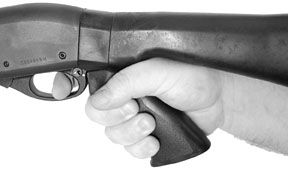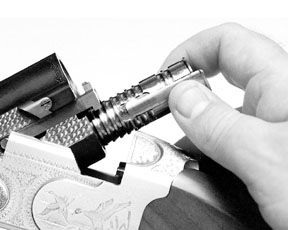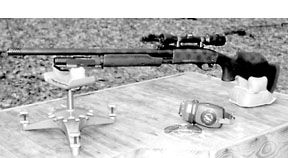
Most shooters have one-dimensional views of their shotguns, and to some extent thats justified. The short-barreled pump gun behind the bedroom door isnt the right tool to take to a sporting clays match, though it will break birds if used properly. Nor should the sporting over/under necessarily be your first pick for deer hunting, and so on.
But what if small changes in your shotguns either improved their primary function or diversified them enough where you could shoot other games-or game-and these changes were relatively easy and inexpensive to make?
We recently tested several aftermarket products that improved the guns on which we fitted them, either in terms of capacity, function, or flexibility.
Pumpgun Upgrades
Advanced Technology Incorporated (ATI) of Versailles, Kentucky, (859) 873-9877, offers a comprehensive selection of parts to hop up or customize nearly any pump or semi-automatic shotgun from Winchester, Remington, and Mossberg.
The range of parts include a tactical replacement forend, a pistol grip forend, a rear pistol grip, a full buttstock with pistol grip, a heat shield, a magazine tube extension, a barrel magazine clamp with sling stud, a shotshell holder, and a flashlight clamp that can be mounted on either the pistol grip forend or pistol grip buttstock. The aforementioned barrel magazine clamp can also double as a flashlight holder should you prefer mounting this accessory under the barrel.
After a recent evaluation of home-defense shotguns, we kept a Remington 870 that was a little low on capacity, and we wanted to see if ATIs magazine extension kit would solve that problem. During the installation, we learned the only tricky part in adding an extension to the 870s magazine tube (rather than replacing it altogether) was removing the dimples inside the magazine that limits travel of the follower, therefore limiting capacity. This steel is pretty hard, and you must remove metal uniformly to keep the loaded rounds and the follower from hanging up. We recommend a patient hand with a round file or, careful now, a Dremel tool. Malfunctions can occur in any tube when there is a flat spot or obstruction inside the tube, so while screwing the extension into place is a no-brainer, installation can be delicate nonetheless. Another source of malfunction that can cause a failure to feed is when the magazine spring is too weak. This would likely show up as the tube empties and compression is waning. This $25.99 part, the +2-round extension with ATI-supplied spring (part number SMR0700), created no malfunctions over 400 test rounds. The Barrel Magazine Clamp (SMC-1100) did come loose, but we solved this with a dab of Loc-Tite.
We also installed the Buttstock with Pistol grip (SP6-0100, $44.95). This involved removing the original stock and adding the designated spacers on the stock bolt to secure a tight fit. A new recoil pad is supplied. Directions for installation on the Winchester, Remington, or Mossberg, Mossberg/Maverick shotguns are on the back of the package, and ATI does a good job in delineating the different installation requirements for each gun. Installation is explained in six steps, and a line drawing illustrating which spacer or platform is needed to adapt to each gun makes it easier to perform than to explain here.
How did we like the pistol grip buttstock? Because the mounting involves a series of intermediate spacers it is not as strong as the original stock. There is some flex involved. But, it did prove plenty strong enough to withstand the pounding of stoppage clearing drills, wherein the butt is slammed against the pavement to free the slide. Ergonomically, we liked it. The pistol grip not only formed a comfortable angle from which to engage the trigger, but it also offered a stronger hold against the shoulder. The standard pistol grip (SR6-0200) is plenty strong enough and installs quickly, making your shotgun far more compact.
We also tried the Tactical forend. This installation looked easier than it turned out to be because this piece involves a myriad of honeycombs that have to be broken away or shaved to fit the individual gun model. This unit is light, appears to be very strong and felt good in our hands. However, this is a function part youll want to take your time hand fitting.
The pistol grip forend was fun to shoot, but ultimately we resisted using it because in our opinion this type of forend could lead to damaging the rails. Should your shotgun be mishandled or even fall over, the pistol grip could act like a lever and torque the rails out of true.
The heat shield (SHS-1300, $19.99) required some bending and stroking to get into position, but once it was in place, we thought it was a good looking piece we would buy. We would suggest placing some tape over the surfaces to prevent scratching during installation.
Gun Tests Recommends
Overall, the conversion and replacement parts from ATI we tried are affordable options that can rejuvenate an older firearm or give you the chance to experiment without getting in over your head, either technically or economically. Even if you bought all the parts we tested, you wouldnt spend much more than $100.
Pistol grip buttstock, $44.95; extension tube, $25.99; heat shield, $19.99; and Tactical forend, $20.99. Buy them. These products added function to our 870 without much muss or fuss.
Pistol grip forend, $24.99. Dont Buy. Though we didnt experience any problems during our test, we worry that the pistol grip could damage a pumpguns rails.
Gauge-Conversion Sets
Upland bird hunters always look forward to late-summer and fall dove, quail, pheasant, grouse, chukkar, and ptarmigan seasons with a mixture of anticipation and anxiety. Trouble is, that safe, reliable break-action 12 gauge shotgun-side by side, over/under, or single shot-that serves so well on waterfowl or turkeys seems a bit much for taking smaller upland birds. Besides, it packs quite a wallop during practice sessions or during days when you may shoot a box or two of shells.
But what if you cant afford a second, smaller-gauge gun? A 20- or 28-gauge upland-bird gun is well suited to putting delectable quail or mourning doves in the skillet, but they cost real American dollars, and the hunter must learn how to shoot with another shotgun.
There is a less expensive way to diversify your gauge offerings-all while using your current break-action scattergun. Sub-gauge tube sets, commonplace in the world of skeet and sporting clays, also have a role in the field.
Sub-gauge tube sets were originally designed and developed by several individuals, but choke-tube wizard Jess Briley was instrumental in the popularization of sub-gauge tube sets. What he and other shooters envisioned was inserting a smaller-gauge barrel inside an existing larger barrel, and adapting the smaller barrel to utilize the existing breechwork. Originally designed for the skeet shooter, the gauge-conversion tubes, usually made of lightweight aluminum, allowed a shooter to use his 12-gauge gun in every gauge competition. Obviously, this was cheaper than buying replacement-barrel sets or additional guns. Moreover, the shooter could employ the same stock, trigger pull, and gun feel for 12-, 20-, and 28-gauge and .410 competitions. Current tube sets on the market add about 10 to 14 ounces to the overall weight of a 12-gauge gun.
In the last decade, gauge-conversion kits have become popular in some field-hunting situations where the shooting volume is likely to be high, such as in South America or Mexico. Drop-in tubes enable the hunter to use smaller gauges, which offer less recoil. If youve already invested in a break-action gun you like, you can add a gauge-conversion set for between $400 and $495, or half that for a single-barrel gun.
Even though the concept makes sense and the dollars seem reasonable, the skeptical hunter has to wonder if the gauge-conversion sets really work. Based on range testing and field experience shooting south Texas doves last year, we have to vote an unqualified yes.

We tested a Briley 28-gauge tube set fitted for a Beretta Silver Pigeon S687EL 12 gauge. The standard weight product (15 ounces for both tubes) cost us $400. Briley, (800) 331-5718, also sells an ultralight set (10 ounces for two tubes) that runs $495.
To install the tube set, the shooter unloads the gun, removes the barrels from the action, and cleans the barrel to remove any residue in the main barrels. If you dont clean the barrels, powder residue and plastic build-up can make for a tight fit and possibly damage the tubess exteriors. Even more important, the outside of the tube should be wiped down to remove any grit that might have collected on it. If this is not done, then the inside of your regular shotgun barrel could be scratched.
Once the gun is clean, the shooter inserts the tube into the breech by hand, sliding the tube fully into the shotgun barrel, up to the last 1/2 inch. At this point he seats the tube with a nylon hammer or an optional Briley Power Knocker. Also, it is important to insert the tube in the proper barrel, making sure in the last 1/2 inch to align the extractor with the integral extractor on the tube. To remove the tubes, the first 1/2 to 1 inch must be tapped out from the muzzle end of the barrels before being gently removed by hand. Cleaning inside the tubes is the same as on any other shotgun.
Our Briley tube set was made of aluminum and had stainless-steel chambers and came with four, series 51, screw-in chokes: two skeet (0.005 constriction), one I/C (0.008 constriction), and one modified (0.014 constriction). Bore size of the tube set was 0.549 inches.
The newest sets from Briley come in color coded tubes to help get the right tube in the right barrel. Ours were red for the top barrel and blue for the bottom.
During our range testing, we wanted to determine if the guns handling characteristics were markedly altered by the tubes. We expected sizable changes in gun movement and target breakage, but our expectations didnt prove out.
Overall, shooters couldnt feel much difference in how the gun came onto target with the tubes in place. Though some weight was added to the front of the gun, it didnt seem to matter. Ditto that in scores. On targets within 30 yards, in fact, our shooters did better with the 28 gauge tubes than they did shooting 12 gauge rounds out of the same gun. On longer shots at 40 yards, however, the higher pellet count of the 12 gauge proved a decisive advantage. Conversely, after a couple of boxes of shells, the shooters gravitated to the 28, which because of its lighter payload and heavier gun weight, had noticeably less kick and stock slap on the shooters faces.
Gun Tests Recommends
Briley Tube Set, $400. Buy it. The advantage to purchasing tube sets instead of a brand-new gun is obvious. For situations where a smaller gauge will do the job-such as upland-bird hunting-you dont have to purchase a gun dedicated to that task. Brileys drop-in gauge-conversion sets can give you the flexibility to change shotshell gauges quickly, and save you hundreds of dollars in the process.
Upgrading Errant Slug Guns
Minute-of-angle slug guns. One-shot kills at 150 yards. Youve undoubtedly read plenty about how todays rifled-barrel shotguns and saboted loads can match some rifles in terms of ballistics and accuracy. But anything inside of 5 inches at 100 yards is asking a lot of an out-of-the-box production slug gun.
That said, production rifles or shotguns can be substantially improved by taking several steps: lightening and stiffening the trigger, replacing and stabilizing the barrel, polishing the crown, verifying that the twist rate is right for your load, replacing the stock, and adding a cheekpad. Heres how:
Upgrade The Trigger
Even if your gun is a buck special with rifle sights and maybe a rifled barrel, its going to have the same receiver, action, and trigger mechanism as its counterpart designed for scattershot. Accordingly, a shotgun trigger is designed to be slapped, not squeezed like a rifle trigger.

Most shotgun triggers pull in the 6- to 10-pound range, and many have substantial creep in them to ward off recoil fire. The good news is that all bolt-action shotgun triggers can be lightened and tightened. Or, barring that, they can be replaced by an adjustable rifle trigger.
The big benefit of a replacement trigger is that it is easily and fully adjustable for weight, creep, and let-off. Weve tried and liked Hastingss ([913] 632-2184) drop-in trigger assembly to fit Remingtons. Most run around $75.
Change The Barrel
The next consideration in improving your slug gun is the barrel. All major manufactures offer rifled choke tubes for their smoothbore guns, which allows the shooter to use saboted ammunition. In our view, however, only a couple of rifled choke tubes-Browning and Beretta-offer significant accuracy past 50 yards. Another option is an aftermarket specialty-rifled slug barrel from Hastings or E.R. Shaw ([412] 221-4343). Hastings has dominated the rifled-barrel aftermarket since the mid-1980s. One of Hastings best products is a vented, rather than ported, barrel. The heavy-walled rifled barrel is slightly belled at the muzzle and has vents cut into it a la the old Cutts Compensator. The new venting has a remarkable effect on reducing recoil and muzzle jump, which can have salutary effects on accuracy.
Other Barrel Options
Immobilizing the barrel is a major step in accurizing any slug gun. Shotgun barrels are notorious for sloppy fit. The answer is to have your barrel fixed to the receiver. The barrels in most slug guns can be pinned with a set screw or actually fixed with Loc-Tite.
If you dont lock it down, the barrel will turn minutely on the threads or move slightly in the receiver every time a slug hits the rifling, says Mark Bansner at Bansners Gunsmithing Specialties ([800] 368-2379) of Adamstown, Pennsylvania. That doesnt mean much at 40 or 50 yards, but it can make tight groups impossible at 100 yards and longer.
Other barrel upgrades include having the crown polished. A surprising number of rifled shotgun barrels have burrs at the muzzle or are unevenly polished in the mass-production frenzy. You wouldnt believe how some barrels come from the factory, Bansner said. A simple polishing makes a world of difference.
Next, make sure the twist rate is right for your particular load. The latest research shows a fast-twist barrel (1 turn in 25 inches or 1 in 28) available from Ithaca, Benelli, Shaw, or Marlin stabilizes saboted ammunition best, while 1-in-34 rates are the best compromise for sabots and short full-bore slugs. A slow twist like 1-in-36 is ideal if youre shooting only full-bore slugs.
Stock Options
Your brand-new state-of-the-art production slug gun probably has a shotgun stock as well. Shotgun stocks are traditionally designed to align your eye with the top of the receiver so that the gun can be pointed, not aimed. Many are cut with sufficient drop to make you shoot slightly high, an aid when shooting at rising flying targets. This design is a detriment to the rifle-like aim needed with slug guns.
Sufficient comb height not only aligns the shooters eye comfortably with the scope but also changes the guns fit to the point where it decreases felt recoil.
Granted, there has been some progress made in this department. Designated slug guns like Ithaca Deerslayer IIs, H&R 980s and 920s, and Remington synthetic SP stocks come with modified Monte Carlo stocks. Mossberg pumps have adjustable combs, and the rifle-like Browning A-Bolt and Savage 210 MasterShot have sufficiently subtle drop to allow viewing through a scope. But everything else on the market needs help.
Bell & Carlson ([316] 225-6688; www.bellandcarlson.com) is marketing a line of high-comb synthetic stocks and matching forearms for a variety of slug gun models, including one for Remingtons that incorporates a high-comb, quick-drop pistol grip design.
A less expensive cure for a low comb is to add a strap-on leather trapshooters pad that raises the comb substantially. Cabelas ([800] 237-4444) markets a couple of sizes to fit various stocks. Brownells ([641] 623-4000; www.brownells.com) sells the Cheek-Eez, a recoil-absorbing and comb-lifting adhesive cheek pad that ranges from 1/8- and 1/4-inch slim-line pads to 3/8- to 1 1/2-inch Scope-Eez models that work well on slug guns.
Solutions For Scopes
Ten years ago a scope on a slug gun was an oddity, like putting fins on a garbage truck. Today, you cant expect to find the full accuracy potential of state-of-the-art slug guns and loads without a good scope.
Again, were talking conventional shotgun receivers here. Most dont have sufficient metal on top (Ithaca Deerslayer IIs are an exception) to drill and tap holes for scope mounting. The alternative is a cantilever scope-mount system attached to the barrel.
B-Square ([817] 923-0964; www.b-square.com) has solved the inevitable scope-movement problem inherent in its old side-saddle mount by redesigning it in a full-saddle configuration that can be bolted completely through the receiver. Millett ([714] 842-5575; www.millettsights.com), Tasco ([305] 591-3670), and other companies also market saddle-style strap-on mounts. B-Square also markets a bolt-on cantilever scope mount designed to affix to raised rib barrels.



























